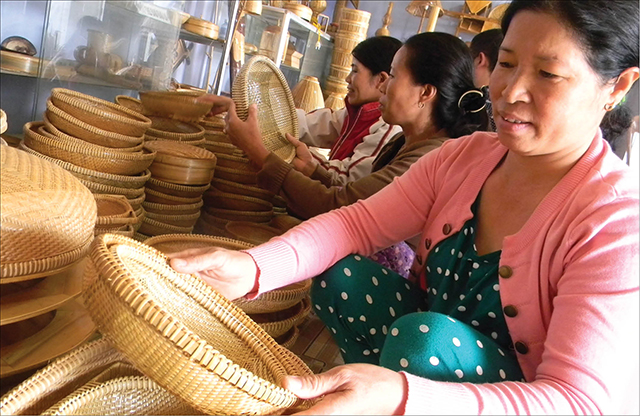
Bao La rattan and bamboo products are engraved with logos by a laser engraver
Limits come from the manual production
Sharing with us in a chat, Mr. Vo Van Dinh - Director of Bao La Rattan and Bamboo Co-operative insisted that they were in short of products for supplying to the market; because of that some orders were cancelled. Meanwhile, the low productivity created low income for workers and affected the production progress.
“The reason for this situation is that most of manufacturing processes of the rattan and bamboo products (such as lamp, bowl, tea tray, dish-cover, candied-fruit tray, basket and furniture...) are handcrafted. Therefore, this time-consuming, low-productivity and small-quantity manufacture could not meet the requirements of large order,” continues Mr. Dinh.
Mr. Nguyen Viet Nam - owner of Co Bang NX facility expresses a concern that it would be easier for craft villagers if they have machine for pounding the Lepironia articulata (gray sedge). So far, all phases for manufacturing a product (such as handbag, hat, pencil case, photo-frame...) have been handcrafted with a low productivity, that also leads to high price and uncompetitiveness.
Mr. Nam adds that to maintain and develop the traditional industry of making Lepironia sleeping mat, he and many villagers has encouraged other people in the village to take care of the grass as well as to weave more products to increase their income. The most difficult and time-consuming phase is pounding Lepironia that decides the productivity, meanwhile, local people could not invest in equipment due to a cost burden.
Value added
With an involvement of over one thousand households, the Ta Oi people's industry of Zeng weaving of A Luoi district has been recognized as national intangible cultural heritage by the Ministry of Culture, Sports and Tourism and created a large number of jobs for idle labor. Before, local people met so many difficulties in the product consumption due to the manual weaving that brought about the low productivity, but high price (approximately 500,000 dongs a sheet) and unequal quality. This also caused a shortage of products to supply to the customers and/or to make students’ uniforms or any other civil products.
In the end of 2018, under the industry promotion fund, the Department of Trade and Industry has funded 35 million dongs to A Co Zeng weaving Co-operative to purchase an advanced weaving frame system with its enclosed accessories that has a productivity of 30m of cloth a day.
Director of the Co-operative Truong Thi Huyen informs that after using this weaving machine, the productivity has increased 4-5 times compared to manual production and reduced products’ prices. Due to the soft fabric and affordable price of the fabric, schools in the district have put many large orders for student uniforms, contributing to restoring this traditional craft and creating jobs for rural labors.
Also, in 2018, Bao La Rattan and Bamboo co-operative received a financial support from the Department of Industry and Trade up to 50% of the laser engravers procurement. The machine is used for carving Hue symbols and mascots on rattan products to enhance their values and qualities.
“At present, we have a laser engraver to brand our name and logo on the products, but due to the financial shortage, the other production phases have to be done by hand. So, we could not receive any large orders,” shared Mr. Dinh.
Technology transfer
|
Speaking at a recent visit to traditional craft villages, Chairman of Provincial People's Committee Phan Ngoc Tho made a request to local co-operatives and manufacturers to improve production procedures, mechanize their production to reduce labor and increase productivity. For their growth, the craft villages must build their own branding, design models and carefully select materials... These craft villages have to conduct more research to work out positive solutions to provide livelihood to their own villagers.
|
In March 2019, the Provincial People's Committee approved the project “Development of Rural Industry to the year 2025” with a total budget of nearly 1,900 billion dongs. The project would invest 110 billion dongs in transferring advanced technology, machine and equipment for the development of the rural industry; developing and applying high technology in producing, processing and consuming agricultural products; restoring and developing traditional craft villages; and enhancing productivity and quality of a number of typical rural industrial products...
In addition, the project also supports vocational training and crafts transferring programs associated with the needs of rural industrial facilities; it also organizes relevant seminars, conferences, workshops and forums on improving capacity of rural industrial production and market development for a sustainable development of rural industry, basing on exploiting local geographical potentials and advantages, materials, high-quality human resource and connecting locals in the key economic zone of the Central region.
Vice Director of Trade and Industry Department Nguyen Luong Bay states that along with the rural industry project, the Department continues to implement support programs for craft villages in purchasing machines, improving models and branding through the industry promotion fund and the craft restoration and development fund. In 2019, the project will be implemented at such traditional craft villages as Bao La rattan and bamboo weaving, Van Cu and O Sa noodle villages and other wood-carving villages.... Particularly, the project will support the market connection and machine and equipment procurements for manufacturers, and provide guidance to the craft villages for a combination between manufacturing by modern equipment and maintaining manual processing at certain stages to produce sophisticated and spectacular products with a reasonable price to expand the market and attract more customers, contributing to increasing the value of industrial production of the province.
Story, photos: Khanh Thu